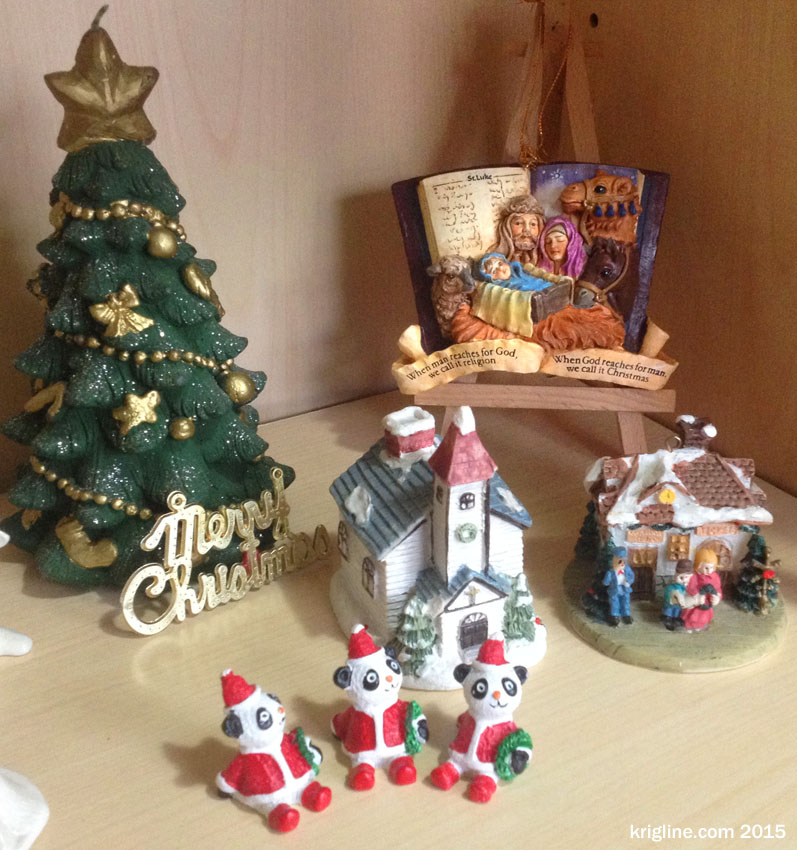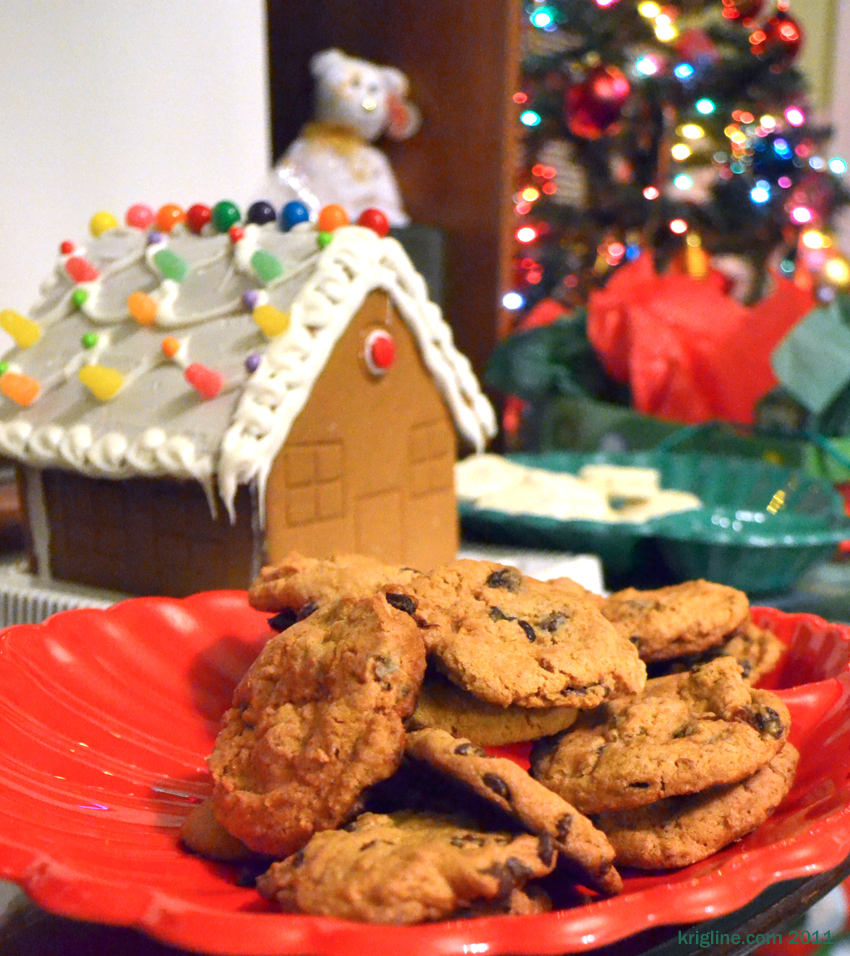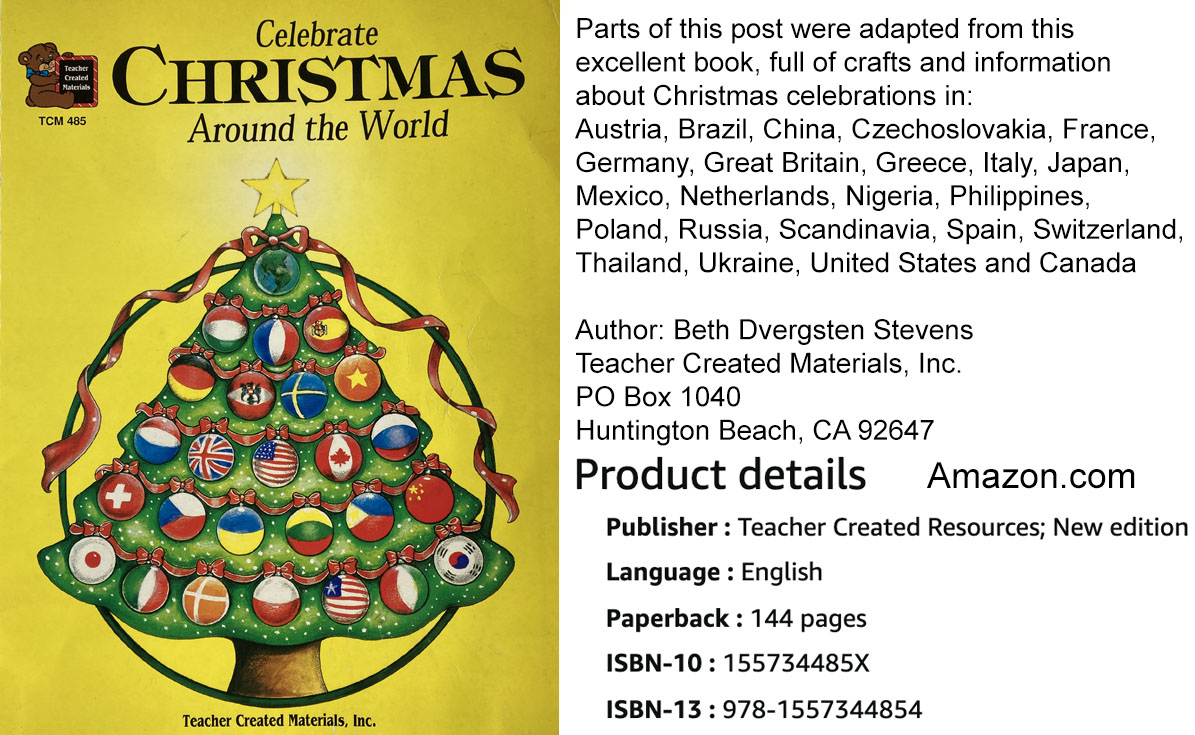Christmas
Christmas commonalities, and an intro to “Silent Night Christmas apples” ⇔
Holiday: Christmas© Dec 2020 Michael Krigline, MA

Note to teachers: Combine these short lessons with a favorite craft to make holiday decorations, and/or a Christmas movie. You’ll find many Christmas resources at EFLsuccess.com (start with the list on the bottom of the “Candy Cane” page).
Underlined terms are explained in the vocabulary section below.
Christmas: an international celebration
 Christmas is the most celebrated holiday in the world. In fact, more than 150 countries recognize Christmas in one way or another. Although Christmas has a Christian origin, many of today’s traditions also include secular practices. Yet, whether it is viewed as a holiday or a holy day, Christmas has become a bustling, hopeful, happy time for people throughout the world.
Christmas is the most celebrated holiday in the world. In fact, more than 150 countries recognize Christmas in one way or another. Although Christmas has a Christian origin, many of today’s traditions also include secular practices. Yet, whether it is viewed as a holiday or a holy day, Christmas has become a bustling, hopeful, happy time for people throughout the world.
Each country’s Christmas celebrations vary according to their climate, beliefs and traditions. However, many practices and symbols are almost universal. Nativity scenes (including the baby, his parents Mary and Joseph, angels, shepherds, and Wise Men) recall Jesus’ humble birth as recorded in the Bible. Bells ring out the good news. Stars and candles represent the light and joy of Christmas. Even candy canes can remind us of the Christmas story.
Gift giving is another common practice. In some countries, gifts are delivered by young girls dressed in white. In others, the giver is some variation of a man dressed in red, known as Father Christmas or Santa Claus (or some translation of the same). Gifts appear (often on Christmas morning) in shoes, stockings, mangers, or under a Christmas tree.
 Ornaments vary from place to place, but often involve the symbols mentioned above. Another universal practice is decoration with greenery and plants with red betties or petals. Though many decorations got started in Europe (Christmas trees, snow scenes, wreaths, tinsel, colored lights…), various nations contributed holiday foods and decor: the popular “Christmas flower” (Poinsettia) came from Mexico. But no matter which country’s traditions are in practice, the spirit of the season tends to remain the same. The expression of joy and hope is as constant as the desire to give to others.
Ornaments vary from place to place, but often involve the symbols mentioned above. Another universal practice is decoration with greenery and plants with red betties or petals. Though many decorations got started in Europe (Christmas trees, snow scenes, wreaths, tinsel, colored lights…), various nations contributed holiday foods and decor: the popular “Christmas flower” (Poinsettia) came from Mexico. But no matter which country’s traditions are in practice, the spirit of the season tends to remain the same. The expression of joy and hope is as constant as the desire to give to others.
Through Christmas celebrations and diverse customs, people renew friendships and family ties, and express wishes for goodwill, peace, and love. So, while customs vary from country to country, it is important to recognize the commonalities shared. Christmas truly is a universal celebration.
Some Quick Facts about Christmas Traditions
Christmas has been celebrated on December 25 since the 4th century, which is also when bells began to symbolize Christmas joy. “Santa Claus” lived in 4th century Turkey. German Christian leader Martin Luther is said to have popularized the Christmas Tree tradition (1500s); its ever-green color stood for eternal life, the shape pointed to heaven, and candles represented Jesus: “the light of the world, born on Christmas.” Christmas cards started in England in 1843. An English person invented the red and white Candy Cane in the 1800s; its symbolism included the first letter of Jesus’ name, or a shepherd’s staff when turned upside down!
Parts of this lesson were adapted from Celebrate Christmas Around the World; see below.
Vocabulary: (underlined terms in either the article above or below; *key terms) For common English abbreviations like sth and sb, see https://eflsuccess.com/common/
- *origin (the origin of sth): where sth came from; the place or situation in which sth began
- *tradition: a belief, custom, or way of doing something that has existed for a long time; [uncountable] all of these beliefs, customs, etc., in general.
- secular: not religious; not related to or under the authority of religious leader
- bustling: full of energetic and noisy activity
- *symbol: a representation; something that reminds us of a great or famous thing/place
- nativity: the place, conditions, or circumstances of being born; this term often refers specifically to the time/way that Jesus was born
- manger: a food container that horses, cattle, etc., eat from
- *ornament: decorations added to make something more beautiful (instead of to make it more useful)
- *commonalities: similar things that many people in a group have or do; things or customs people have in common
Discussion:
- Ask another student a question about the text, such as: “How many countries recognize Christmas?”
- What Christmas symbols are mentioned? What is your favorite symbol?
- Do you have a question about the pieces of a nativity scene? If you know the original story, which character in a nativity scene would you want to have been that “first Christmas”?
- Who gives Christmas gifts in different countries? Is there a special “gift giver” in your country?
- Some people add an ornament to their tree each Christmas, to represent the past year. What would your “annual ornament” be this year?
- Many people get depressed at Christmas-time. Why do you think this happens?
- The Bible says that Christmas is mainly about God’s great gift to the world. Who can explain what this means? Why did God send Jesus to be “Immanuel” (God with us)?
- Tell us about your favorite Christmas tradition, memory, song, etc.
If you have time, watch the Columbia International Festival’s YouTube Premiere: “Christmas Around the World” (which we helped to produce). YouTube channel:
https://www.youtube.com/channel/UCtC5ZcYt_u62t5iIcvfH8Ag/featured
EFLsuccess.com; original content ©Michael Krigline, all rights reserved. This resource was created for our students under my understanding of “fair use” for educational resources. As far as I am concerned, people are allowed to print/copy it for personal or classroom use. See our Website Standards and Use Policy.
~ ~ ~ ~ ~ ~ advertisement ~ ~ ~ ~ ~ ~

